Sanctuary
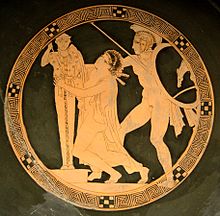
Ajax violates Cassandra's sanctuary at the Palladium: tondo of an Attic cup, ca. 440–430 BCE
A sanctuary, in its original meaning, is a sacred place, such as a shrine. By the use of such places as a haven, by extension the term has come to be used for any place of safety. This secondary use can be categorized into human sanctuary, a safe place for humans, such as a political sanctuary; and non-human sanctuary, such as an animal or plant sanctuary.
Contents
1 Religious sanctuary
1.1 Sanctuary as area around the altar
1.2 Sanctuary as a sacred place
2 Human sanctuary
2.1 Legal sanctuary
2.1.1 Right of asylum
2.1.2 Political asylum
2.2 Sanctuary movement in modern times
3 Other uses
4 Non-human sanctuary
4.1 Animal sanctuary
4.2 Plant sanctuary
5 See also
6 References
7 Further reading
8 External links
Religious sanctuary
Sanctuary is a word derived from the Latin sanctuarium, which is, like most words ending in -arium, a container for keeping something in—in this case holy things or perhaps cherished people (sanctae/sancti). The meaning was extended to places of holiness or safety, in particular the whole demarcated area, often many acres, surrounding a Greek or Roman temple; the original terms for these are temenos in Greek and fanum in Latin, but both may be translated as sanctuary. Similar usage may be sometimes found describing sacred areas in other religions. In Christian churches "sanctuary" has a specific meaning, covering part of the interior, covered below.
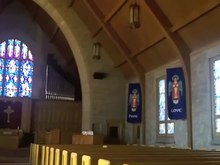 Play media
Play mediaTwo sanctuaries in Wisconsin
Sanctuary as area around the altar

The sanctuary at St. Mary's Cathedral, Sydney
In many Western Christian traditions including Roman Catholic, Lutheran, Methodist, and Anglican churches, the area around the altar is called the sanctuary; it is also considered holy because of the physical presence of God in the Eucharist, both during the Mass and in the church tabernacle the rest of the time.
In many churches the architectural term chancel covers the same area as the sanctuary, and either term may be used.[1] In some Protestant churches, the term sanctuary denotes the entire worship area while the term chancel is used to refer to the area around the altar-table.
In many Western traditions altar rails sometimes mark the edge of the sanctuary or chancel. In the Eastern Orthodox Church, Eastern Catholic Churches of Syro-Malabar Church, Byzantine rite and Coptic Orthodox Churches, the sanctuary is separated from the nave (where the people pray) by an iconostasis, literally a wall of icons, with three doors in it. In other Oriental Orthodox traditions, a sanctuary curtain is used.
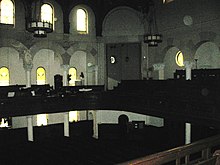
The back of the church sanctuary at Church of St. Paul and St. Andrew.
The terminology that applies the word "sanctuary" to the area around the altar does not apply to Christian churches alone: King Solomon's temple, built in about 950 BC, had a sanctuary ("Holy of Holies") where the Ark of the Covenant was, and the term applies to the corresponding part of any house of worship. In most modern synagogues, the main room for prayer is known as the sanctuary, to contrast it with smaller rooms dedicated to various other services and functions. (There is a raised bimah in the sanctuary, from which services are conducted, which is where the ark holding the Torah may reside; some synagogues, however, have a separate bimah and ark-platform.)
Sanctuary as a sacred place
In Europe, Christian churches were sometimes built on land considered to be a particularly holy spot, perhaps where a miracle or martyrdom was believed to have taken place or where a holy person was buried. Examples are St. Peter's Basilica in Rome and St. Albans Cathedral in England, which commemorate the martyrdom of Saint Peter (the first Pope) and Saint Alban (the first Christian martyr in Britain), respectively.
The place, and therefore the church built there, was considered to have been sanctified (made holy) by what happened there. In modern times, the Catholic Church has continued this practice by placing in the altar of each church, when it is consecrated for use, a box (the sepulcrum) containing relics of a saint. The relics box is removed when the church is taken out of use as a church. In the Eastern Orthodox Church, the antimension on the altar serves a similar function. It is a cloth icon of Christ's body taken down from the cross, and typically has the relics of a saint sewn into it. In addition, it is signed by the parish's bishop, and represents his authorization and blessing for the Eucharist to be celebrated on that altar.
Human sanctuary
Legal sanctuary
In the classical world, some (but not all) temples offered sanctuary to criminals or runaway slaves. When referring to prosecution of crimes, sanctuary can mean one of the following:
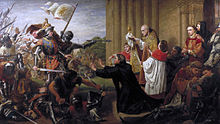
The Church as a Place of Refuge
- Church sanctuary
- A sacred place, such as a church, in which fugitives formerly were immune to arrest (recognized by English law from the fourth to the seventeenth century).[2] While the practice of churches offering sanctuary is still observed in the modern era, it no longer has any legal effect and is respected solely for the sake of tradition.
- Political sanctuary
- Immunity to arrest afforded by a sovereign authority. The United Nations has expanded the definition of "political" to include race, nationality, religion, political opinions and membership or participation in any particular social group or social activities. People seeking political sanctuary typically do so by asking a sovereign authority for asylum.
Right of asylum
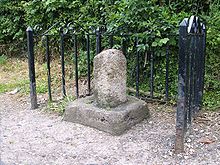
Remains of one of four medieval stone boundary markers for the sanctuary of Saint John of Beverley in the East Riding of Yorkshire
Many ancient peoples recognized a religious right of asylum, protecting criminals (or those accused of crime) from legal action and from exile to some extent. This principle was adopted by the early Christian church, and various rules developed for what the person had to do to qualify for protection and just how much protection it was.
In England, King Æthelberht made the first laws regulating sanctuary in about AD 600, though Geoffrey of Monmouth in his Historia Regum Britanniae (c. 1136) says that the legendary pre-Saxon king Dunvallo Molmutius (4th/5th century BC) enacted sanctuary laws in the Molmutine Laws as recorded by Gildas (c. 500–570).[3] By Norman times, there had come to be two kinds of sanctuary: All churches had the lower-level kind, but only the churches the king licensed had the broader version. The medieval system of asylum was finally abolished entirely in England by James I in 1623.[4]
Political asylum
During the Wars of the Roses of the 15th century when the Lancastrians or Yorkists would suddenly gain the upper hand by winning a battle, some adherents of the losing side might find themselves surrounded by adherents of the winning side and unable to return to their own side, so they would rush to sanctuary at the nearest church until it was safe to leave it. A prime example is Queen Elizabeth Woodville, consort of Edward IV of England.
In 1470, when the Lancastrians briefly restored Henry VI to the throne, Edward's queen was living in London with several young daughters. She moved with them into Westminster for sanctuary, living there in royal comfort until Edward was restored to the throne in 1471 and giving birth to their first son Edward during that time. When King Edward IV died in 1483, Elizabeth (who was highly unpopular with even the Yorkists and probably did need protection) took her five daughters and youngest son (Richard, Duke of York; Prince Edward had his own household by then) and again moved into sanctuary at Westminster. She had all the comforts of home; she brought so much furniture and so many chests that the workmen had to break holes in some of the walls to move everything in fast enough to suit her.[citation needed]
In the 20th century, during World War I, all of Russia's Allies made the controversial decision in 1917 to deny political sanctuary to Tsar Nicholas II and his immediate family when he was overthrown in that year's February Revolution for his abuses of power and forced to abdicate in March in favor of Alexander Kerensky's Russian Provisional Government. Nicholas and his family and remaining household were sent to Tobolsk, Siberia that summer while Kerensky kept Russia in the war when it couldn't win, enabling Lenin and his Bolsheviks to gain the Russian people's support in overthrowing Kerensky's regime in that year's October Revolution. The Russian Civil War started that November and in July, 1918, with Lenin losing the civil war, Nicholas and his family were executed on Lenin's orders while confined to the Ipatiev House in Yekaterenburg. In 1939, months before World War II began, more than 900 Jewish refugees from Nazi Germany on board the MS St. Louis met the same fate, first by Cuba—their original destination—and afterwards by the United States and Canada. As a result, most of them were forced back to Europe, where over 600 of them died in Nazi concentration camps during the war. This incident was the subject of Gordon Thomas' and Max-Morgan Witts' 1974 novel, Voyage of the Damned and its 1976 movie adaptation. In 1970, Simonas Kudirka attempted to defect from the then-Soviet Union by jumping from his "mother ship", 'Sovetskaya Litva', onto the USCGC Vigilant when it was sailing from New Bedford while Kudirka's ship was anchored at Martha's Vineyard. Kudrika was accused of stealing 3,000 rubles from Sovetskaya Litva's safe and when the U.S. State Department failed to help him, Kudrika was sent back to the Soviet Union, where he was convicted of treason and sentenced to ten years of hard labor but because Kudirka could claim American citizenship through his mother, he was allowed to return to the United States in 1974. His plight was the subject of Algis Ruksenas' 1973 book Day of Shame: The Truth About The Murderous Happenings Aboard the Cutter Vigilant During the Russian-American Confrontation off Martha's Vineyard and the 1978 TV movie The Defection of Simas Kudirka, starring Alan Arkin in the title role. In the 1980s, Ukrainian youth, Walter Polovchak, became a cause celebre because of his request in 1980 at age 12 to remain in the United States permanently after he announced that he didn't want to return with his parents to what was then Soviet Ukraine, and was the subject of a five-year struggle between U.S. and Soviet courts over his fate, which was decided in his favor in 1985 when Walter turned 18 that October 3 and was no longer a juvenile and thus no longer under any requirements to return to his parents if he didn't want to. Later in the 1980s, Estonian national and alleged Nazi war criminal, Karl Linnas, was the target of several sanctuary denials outside the United States before he was finally returned in 1987 to the then-USSR to face a highly likely death penalty for alleged war crimes that he was convicted of in 1962 (see Holocaust trials in Soviet Estonia). Linnas died in a Leningrad prison hospital on July 2, 1987 while waiting for a possible retrial in Gorbachev-era courts, 25 years after Khrushchev-era courts convicted him in absentia.
Sanctuary movement in modern times
Sanctuary of refugees from Central American civil wars was a movement in the 1980s. Part of a broader anti-war movement positioned against U.S. foreign policy in Central America, by 1987, 440 cities in the United States had been declared "sanctuary cities" open to migrants from these civil wars in Central America.
These sites included university campuses and cities. From the 1980s continuing into the 2000s, there also have been instances of churches providing "sanctuary" for short periods to migrants facing deportation in Germany, France, Belgium, the Netherlands, Norway, Switzerland, Australia and Canada, among other nations. In 2007, Iranian refugee Shahla Valadi was granted asylum in Norway after spending seven years in church sanctuary after the initial denial of asylum.[5] From 1983 to 2003 Canada experienced 36 sanctuary incidents.[6] The "New Sanctuary Movement" organization estimates that at least 600,000 people in the United States have at least one family member in danger of deportation.[7] In 2016, an Icelandic church declared that they would harbour two failed asylum seekers who violated the Dublin Regulation, and police removed them for deportation, as ecclesiastical immunity has no legal standing.[8]
Other uses
When referring to a shelter from danger or hardship, sanctuary can mean one of the following:
- Shelter sanctuary
- A place offering protection and safety; a shelter, typically used by displaced persons, refugees, and homeless people.
- Humanitarian sanctuary
- A source of help, relief, or comfort in times of trouble typically used by victims of war and disaster.
- Institutional sanctuary
- An institution for the care of people, especially those with physical or mental impairments, who require organized supervision or assistance.
The term "sanctuary" has further come to be applied to any space set aside for private use in which others are not supposed to intrude, such as a "man cave".
Non-human sanctuary
Animal sanctuary
An animal sanctuary is a facility where animals are brought to live and be protected for the rest of their lives. Unlike animal shelters, sanctuaries do not seek to place animals with individuals or groups, instead maintaining each animal until its natural death.
Plant sanctuary
Plant sanctuaries are areas set aside to maintain functioning natural ecosystems, to act as refuges for species and to maintain ecological processes that cannot survive in most intensely managed landscapes and seascapes. Protected areas act as benchmarks against which we understand human interactions with the natural world.
See also
- Elvira Arellano
- La Iglesia de Nuestra Señora la Reina de los Ángeles
- Shrine
References
^ Robinson, Gary (1 January 2006). Architecture. Lotus Press. p. 40. ISBN 9788189093129.In the historic floor plan, the words chancel and sanctuary are often synonymous.
.mw-parser-output cite.citation{font-style:inherit}.mw-parser-output q{quotes:"""""""'""'"}.mw-parser-output code.cs1-code{color:inherit;background:inherit;border:inherit;padding:inherit}.mw-parser-output .cs1-lock-free a{background:url("//upload.wikimedia.org/wikipedia/commons/thumb/6/65/Lock-green.svg/9px-Lock-green.svg.png")no-repeat;background-position:right .1em center}.mw-parser-output .cs1-lock-limited a,.mw-parser-output .cs1-lock-registration a{background:url("//upload.wikimedia.org/wikipedia/commons/thumb/d/d6/Lock-gray-alt-2.svg/9px-Lock-gray-alt-2.svg.png")no-repeat;background-position:right .1em center}.mw-parser-output .cs1-lock-subscription a{background:url("//upload.wikimedia.org/wikipedia/commons/thumb/a/aa/Lock-red-alt-2.svg/9px-Lock-red-alt-2.svg.png")no-repeat;background-position:right .1em center}.mw-parser-output .cs1-subscription,.mw-parser-output .cs1-registration{color:#555}.mw-parser-output .cs1-subscription span,.mw-parser-output .cs1-registration span{border-bottom:1px dotted;cursor:help}.mw-parser-output .cs1-hidden-error{display:none;font-size:100%}.mw-parser-output .cs1-visible-error{font-size:100%}.mw-parser-output .cs1-subscription,.mw-parser-output .cs1-registration,.mw-parser-output .cs1-format{font-size:95%}.mw-parser-output .cs1-kern-left,.mw-parser-output .cs1-kern-wl-left{padding-left:0.2em}.mw-parser-output .cs1-kern-right,.mw-parser-output .cs1-kern-wl-right{padding-right:0.2em}
^ "Sanctuary, Violence, and Law in Late Medieval England - Events". Worldwide Universities Network.
^ Geoffrey of Monmouth, Historia Regum Britanniae 2, 17
^ "English Coroner System Part 4: Sanctuary". Encyclopædia Britannica Online.
^ "Iranian given asylum in Norway". News24.com.
^ See Randy K. Lippert (2005). Sanctuary, Sovereignty, Sacrifice: Canadian Sanctuary Incidents, Power and Law.
ISBN 0-7748-1249-4
^ "Elvira Arellano Arrested Outside Downtown Church: Chicago Immigration Activist Taken Into Custody Sunday Afternoon" CBS2.com
^ "Asylum seekers dragged out of church by Reykjavik Police".
Further reading
- J. Charles Cox (1911). The Sanctuaries and Sanctuary Seekers of Medieval England On Archive.org
- John Bellamy (1973). Crime and Public Order in England in the Later Middle Ages.
Richard Kaeuper (1982). "Right of asylum". Dictionary of the Middle Ages. v.1 pp. 632–633.
ISBN 0-684-16760-3
Jean Calmard (1988). "Bast (sanctuary, asylum)". Encyclopædia Iranica.
External links
- Sanctuary Movement history on New Standards
Sanctuary in church architecture – from the Catholic Encyclopedia
Sanctuary as a place of refuge – from the Catholic Encyclopedia

Comments
Post a Comment